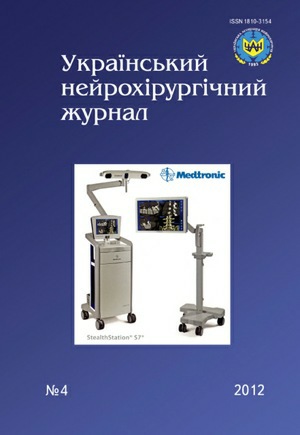Influence of cerebral and extracerebral factors on the prognosis of surgical treatment of hemorrhagic stroke
DOI:
https://doi.org/10.25305/unj.55644Keywords:
hemorrhagic stroke, cerebral insufficiency, systemic inflammatory response syndrome, organ failure, multiple organ failureAbstract
Introduction. Hemorrhagic stroke frequency ranges from 10 to 39% in a structure of acute brain vascular diseases. Their treatment is usually conservative. Today surgical treatment is used also.
Materials and methods. 221 patients were examined after surgical treatment, 119 of them survived, 102 — died. To estimate patients’ state severity SOFA scale was used.
Results. Hemorrhagic stroke in early postoperative period in 54% patients was accompanied by cerebral insufficiency (consciousness impairments according to Glasgow Coma Scale 9 points and less) in 46% — by cerebral dysfunction (Glasgow Coma Scale 10–14 points). At cerebral insufficiency more often lung (in 69%), heart (in 81%) and kidney (in 15%) failure were observed. Frequency of acute cerebral insufficiency is also closely linked with systemic inflammatory response syndrome (SIRS). Expression of heart, lungs and kidneys dysfunction and SIRS criteria (pulse, blood pressure, body temperature, white blood cells quantity) in early postoperative period change parallel with Glasgow Coma Scale parameters. Close correlation was revealed between indicators of multiple organ failure syndrome and SIRS in alive patients, there was no correlation before the lethal outcome. This indicates the decisive role of central nervous system in homeostasis regulation.
References
1. Maltseva L, Kobelyatskiy Y, Panchenko G. Gemorragicheskiy insult glazami vracha anesteziologa [Hemorrhagic stroke eyed anesthesiologist]. Vestn intensiv terapii. 2009;2:17-21. Russian. [eLIBRARY.ru]
2. Rabenok LS, Regush AV. [Сerebrospinal fluid drainage in the treatment of haemorrhages in the ventricular system]. Ukr Med Chasopys. 2010:1;87–90. Ukrainian. [Publisher Abstract/Full Text]!
3. Ishizaki T, Imanaka Y, Sekimoto M, Fukuda H, Mihara H. Comparisons of risk-adjusted clinical outcomes for patients with aneurysmal subarachnoid haemorrhage across eight teaching hospitals in Japan. J Eval Clin Pract. 2008;14(3):416-421. [CrossRef] [PubMed]
4. Kamenska OI, Chepky LP, Tsimeyko OA, Моroz VV. [Influence of presurgical cerebral and extracerebral factors on lethality in surgical treatment of hemorrhagic stroke]. Ukrainian Neurosurgical Journal. 2012;(1):43-48. Ukrainian.
5. Minov S. Osoblyvosti prohnozuvannya i profilaktyky rannoyi poliorhannoyi nedostatnosti pry cherepno-mozkoviy travmi [Features prediction and early prevention of multiple organ failure in traumatic brain injury] [dissertation]. Kiev (Ukraine): Shupyk National Medical Academy of Postgraduate Education. 2011. Ukrainian.
6. Zygun D, Doig C, Gupta A et al. Non-neurological organ dysfunction in neurocritical care. Journal of Critical Care. 2003;18(4):238-244. [CrossRef] [PubMed]
7. Sizov D, Kostyuchenko A, Belskikh A. Sindrom posledovatelnykh organnykh povrezhdeniy v kriticheskikh sostoyaniyakh [The syndrome of consecutive organ damage in critical conditions]. Anesteziologiya i reanimatologiya. 2007;2:22-25. Russian.
8. Baue A, Faist E, Fry D. Multiple Organ Failure:pathophysiology, prevention and therapy. New York: Springer; 2000.
Downloads
Published
How to Cite
Issue
Section
License
Copyright (c) 2012 Leonard Chepkiy, Orest Tsimeyko, Olga Kamenska, Volodymyr Моroz

This work is licensed under a Creative Commons Attribution 4.0 International License.
Ukrainian Neurosurgical Journal abides by the CREATIVE COMMONS copyright rights and permissions for open access journals.
Authors, who are published in this Journal, agree to the following conditions:
1. The authors reserve the right to authorship of the work and pass the first publication right of this work to the Journal under the terms of Creative Commons Attribution License, which allows others to freely distribute the published research with the obligatory reference to the authors of the original work and the first publication of the work in this Journal.
2. The authors have the right to conclude separate supplement agreements that relate to non-exclusive work distribution in the form of which it has been published by the Journal (for example, to upload the work to the online storage of the Journal or publish it as part of a monograph), provided that the reference to the first publication of the work in this Journal is included.









